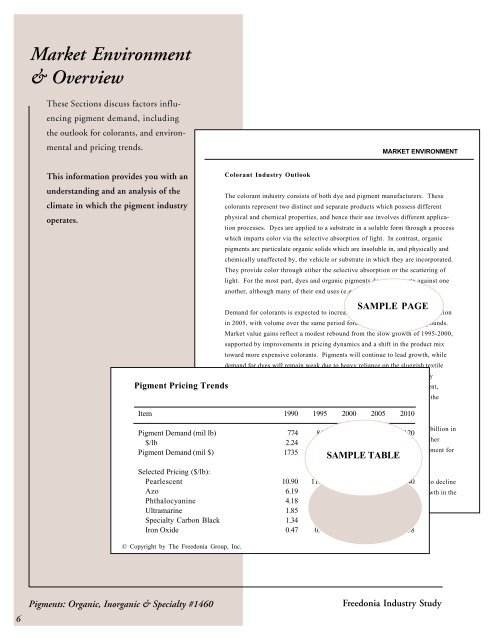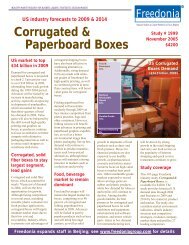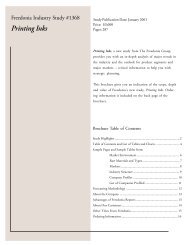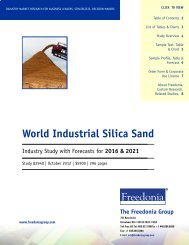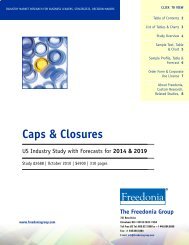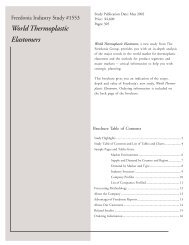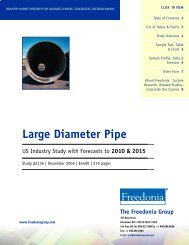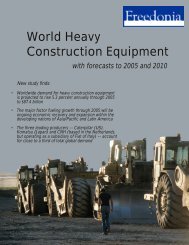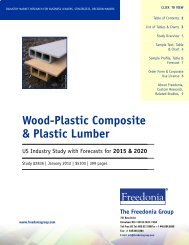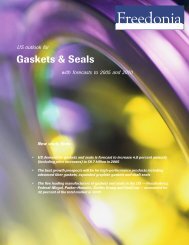Pigments: Organic, Inorganic & Specialty - The Freedonia Group
Pigments: Organic, Inorganic & Specialty - The Freedonia Group
Pigments: Organic, Inorganic & Specialty - The Freedonia Group
Create successful ePaper yourself
Turn your PDF publications into a flip-book with our unique Google optimized e-Paper software.
Market Environment& Overview<strong>The</strong>se Sections discuss factors influencingpigment demand, includingthe outlook for colorants, and environmentaland pricing trends.MARKET ENVIRONMENTThis information provides you with anunderstanding and an analysis of theclimate in which the pigment industryoperates.Colorant Industry Outlook<strong>The</strong> colorant industry consists of both dye and pigment manufacturers. <strong>The</strong>secolorants represent two distinct and separate products which possess differentphysical and chemical properties, and hence their use involves different applicationprocesses. Dyes are applied to a substrate in a soluble form through a processwhich imparts color via the selective absorption of light. In contrast, organicpigments are particulate organic solids which are insoluble in, and physically andchemically unaffected by, the vehicle or substrate in which they are incorporated.<strong>The</strong>y provide color through either the selective absorption or the scattering oflight. For the most part, dyes and organic pigments do not compete against oneanother, although many of their end uses (e.g., in printing inks) overlap.Demand for colorants is expected to increase 3.3 percent per year to $4.8 billionin 2005, with volume over the same period forecast to reach 1.5 billion pounds.Market value gains reflect a modest rebound from the slow growth of 1995-2000,supported by improvements in pricing dynamics and a shift in the product mixtoward more expensive colorants. <strong>Pigments</strong> will continue to lead growth, whiledemand for dyes will remain weak due to heavy reliance on the sluggish textileindustry. Unit price increases for colorants will lag inflation, restrained bydownward pricing pressure from low cost dye imports and, to a lesser extent,classical pigments. Nevertheless, increases will be supported by a shift in theproduct mix toward higher priced pigments.Item 1990 1995 2000 2005 2010Pigment Pricing TrendsDemand for pigments is expected to grow 4.8 percent per annum to $3.5 billion inPigment Demand (mil lb) 774 840 915 1010 11202005, driven by above average gains in high performance, metallic and other$/lb 2.24 2.55 2.99 3.43 3.90Pigment Demand (mil $) specialty types. However, 1735 global 2145 overcapacity and a soft pricing environment forSAMPLE2740TABLE3460 4370classical pigments will limit gains.Selected Pricing ($/lb):PearlescentAzoIn contrast to the growing 10.90 pigments 11.45market, 12.20 demand 12.80 for dyes is 13.40 forecast to declineslightly to $1.3 billion 6.19 in 2005. 6.44 Gains will 6.82 be restrained 7.18by lackluster 7.50 growth in thePhthalocyanine 4.18 4.67 4.56 4.59 4.66Ultramarine 1.85 2.51 3.51 4.15 4.80<strong>Specialty</strong> Carbon Black 1.34 1.40 1.45 1.52 1.60Iron Oxide 0.47 0.48 0.52 0.55 0.58© Copyright by <strong>The</strong> <strong>Freedonia</strong> <strong>Group</strong>, Inc.SAMPLE PAGE6<strong>Pigments</strong>: <strong>Organic</strong>, <strong>Inorganic</strong> & <strong>Specialty</strong> #1460<strong>Freedonia</strong> Industry Study


